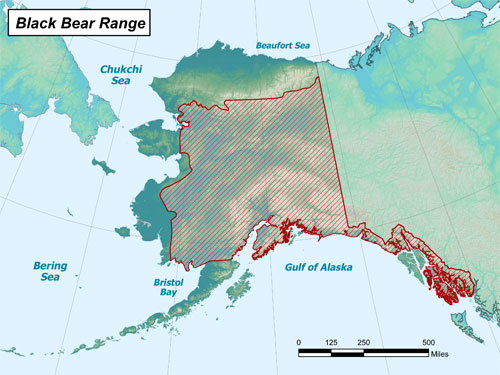Black Bear Hunting in Alaska
Life History

Tracks
Tracks are smaller than brown bears and have a greater distance between the toes that are arranged in an arc.

Scat
The diet of black bears consists of meat that causes variable scat. Fresh scat will smell of what the animal just ate, with vegetation underneath it still fresh.
An estimated 100,000 black bears (Ursus americanus) inhabit Alaska. Statewide, the annual harvest increased steadily between 2003 and 2007, from about 2,500 to 3,250 bears.
Adult black bears stand about 29 inches (0.73 m) at the shoulders and measure about 60 inches (1.5 m) from nose to tail. Males are larger than females. An average adult male in spring weighs about 180 – 200 lbs (81.8 – 90.9 kg). Bears weigh considerably less when they emerge from winter dormancy; they may weigh 20 percent more in the fall after putting on layers of fat prior to hibernation. A 350-lb (159-kg) black bear will dress out at about 210 lbs (95 kg), yielding about 120 lbs (54 kg) of meat.
Black bears can vary in color from jet black to white. Black is the color encountered most frequently across the state, but brown or cinnamon-colored black bears are sometimes seen in Southcentral Alaska and on the southeastern mainland. Cinnamon-colored black bears are also common in Alaska’s Interior. Some bluish-colored bears called glacier bears may be found in the Yakutat area and in other parts of Southeast Alaska. Black bears often have brown muzzles and some also have a patch of white hair on their chest.
Black bears are opportunistic when it comes to food. However, they do follow certain predictable patterns. In the spring, freshly sprouted vegetation, including grass, horsetails, and poplar buds are an important food source for bears. Bears readily scavenge winter-killed animals, and in some areas black bears are effective predators on newborn moose calves. As summer progresses, feeding shifts to salmon if that resource is available. In areas without salmon, black bears feed primarily on vegetation throughout the year. Berries, especially blueberries, are an important late summer-fall food item. Ants, grubs, and other insects help to round out the black bear's diet. Male bears also prey on cubs.
In Alaska, black bears occur over most of the forested areas of the state; depending on the season of the year, they may be found from sea level to alpine areas. They are not found on the Seward Peninsula, on the Yukon-Kuskokwim Delta, or north of the Brooks Range. They are also absent from some of the large islands of the Gulf of Alaska, notably Kodiak, Montague, Hinchinbrook and others, and from the Alaska Peninsula south of the Lake Iliamna area. In Southeast Alaska, black bears occupy most islands with the exceptions of Admiralty, Baranof, Chichagof, and Kruzof; these are inhabited by brown bears. Both bear species occur on the southeastern mainland.

